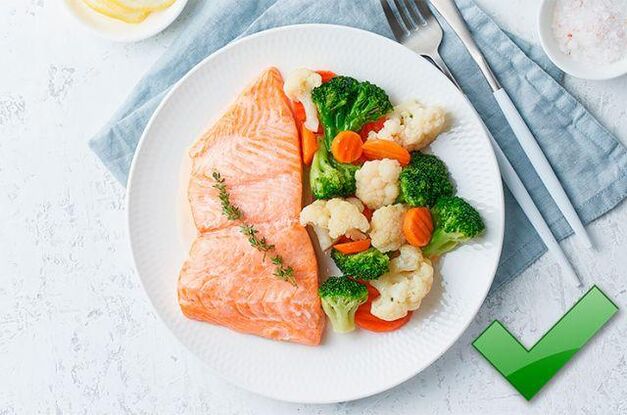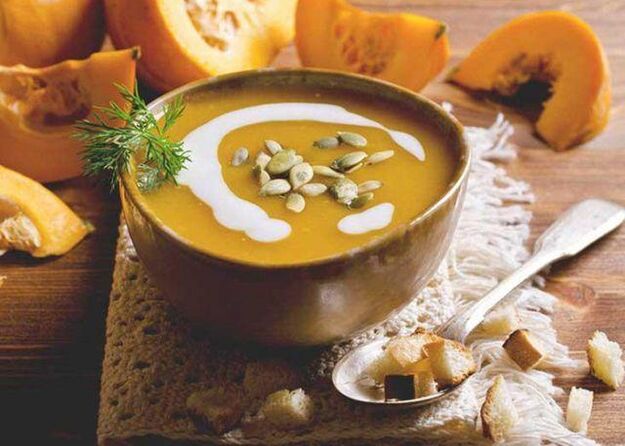
This unpleasant, even dangerous disease is considered the most common pathology of the gastrointestinal tract of modern people. Most often this is due to a violation of the diet, but the wrong products themselves can cause its development. Diet for gastritis is as important as drug treatment, and sometimes it is almost the only way to normalize the work of the gastrointestinal tract and prevent the disease from developing into a dangerous form. more dangerous and/or painful.
What is gastritis?
Gastritis is an inflammatory process that develops on the stomach lining. Due to its improper functioning, digestion is disrupted, various negative effects develop, and the mucosa itself gradually becomes thinner.
The cause of the disease can be due to various factors that are not unfamiliar to a modern, busy person. Rushing in meals, improperly picking and chewing hot or cold foods, consuming poor quality or harmful foods, fast, fatty, salty and smoked foods in unlimited quantities, eating disorders withsystem - all of these can cause gastritis. In addition, insufficient amounts of protein and vitamins in food, long-term use of certain medications, constant stress, smoking and mindless excessive alcohol consumption also become risk factors.
Nutritional rules for gastritis
Properly organized nutrition plays a huge role in the treatment of this disease. It is very important to know the rules and follow all the subtleties of a diet for gastritis with high or low acidity, compiled by a doctor. There are some simple and clear rules that you will have to follow:
- All food must be chewed thoroughly, you cannot swallow food piece by piece.
- You should arrange your daily routine and eat by the hour. Ideally, meals should be portioned and servings should be small. It is better to eat 5-6 times, with a portion of 200-250 grams, than three times 500-600.
- Between meals should be left 2, 5-3 hours and preferably equal intervals, if possible.
- Food should always be warm, not hot or cold. The wrong temperature irritates the stomach wall, causing more inflammation.
- You should stop eating raw food. It is better when they have been heat treated, even when they are added to vegetables and fruits.
In addition, it is very important that the products are always fresh, cooking for future use with gastritis is undesirable and even dangerous.
What can you eat when you have gastritis?

- Stale bread, scones and cakes in general.
- Boiled, steamed, boiled or grilled vegetables (without the skin).
- Porridge from cereals ground in milk or water (rice, oatmeal, semolina, buckwheat).
- Low-fat fish.
- Lean unroasted meat and poultry (chicken, turkey, rabbit, veal).
- Non-acidic fruits, dishes from them (apple, banana, pear).
- Low-fat milk and dairy products (up to 1. 5%).
- Vegetables and butter (no more than 20-30 grams per day).
- Pastila, marshmallows.
- Natural honey (40-50 grams).
- Steamed eggs, as part of dishes or boiled (2 pieces per day).
It is very important for gastritis to adhere to the correct oral regimen. It is necessary to consume 1. 5-2 liters of fluids per day, including juices, juices and even soups. It is allowed to drink mineral water with suitable ingredients recommended by the doctor.
What to eat with gastritis
- Smoked meats and sausages.
- Sausages and sausages.
- Grilled meat.
- Fatty meat and fish.
- Sour and berries.
- pea.
- Fresh vegetables that have not been heat-treated.
- Preservation and pickling.
- Yogurt and fatty products.
- Barley, millet, cereals are not surrounded.
- Macaroni, pasta and vermicelli made from whole wheat flour.
- Fresh pastries and bread.
- Mushroom.
- Nuts and seeds.
- Vinegar.
- Hot sauce and condiments.
- Strong coffee, tea, carbonated drinks.
- Wine.
* The list of prohibited and allowed products may vary slightly, depending on the type of gastritis, therefore, for detailed clarification, it is better to contact your doctor.
No. 1 diet for gastritis: principles and sample menus

Such a system of nutrition is recommended for people with acute gastritis. A similar sparing regimen is also prescribed for people with gastric or duodenal ulcers. The same principles and rules as above. In addition, doctors recommend cutting back on salt intake, as it not only retains fluid in the body, but also irritates the mucous membranes. The standard calorie content in this regimen should not exceed 2800-3000 calories per day. Let's take a look at the sample menu of the day for a deeper understanding of the matter:
- Breakfast: rice porridge with milk, soft boiled eggs, milk tea.
- Snack: sweet apple baked with honey or sugar.
- Lunch: vegetable cream soup, steamed turkey or meatballs, mashed potatoes with milk, non-sour fruit mousse.
- Snack: toast, rosehip broth.
- Dinner: vegetable stew, fish is allowed, baked with milk, weak tea with milk.
- Snack before bed: banana, milk.
Diet for chronic gastritis
When the disease becomes chronic, dietary restriction becomes vital for the patient. By following the diet, you can prevent exacerbations of the disease, significantly improving your quality of life. For different degrees of acidity, the menu may be slightly different, so it is necessary to talk about each case separately.
Nutrition for chronic gastritis with low acidity
The stomach begins to produce insufficient amounts of hydrochloric acid, food is digested much worse. The body cannot extract from it all the nutrients and trace elements it needs. Not only the mucous membranes of the organs but all the systems of our body can suffer from this condition.
Diet principles
- It is better to consume pureed, liquid and pureed dishes.
- It is acceptable to consume acidic foods.
- During remission, you can eat fried food with a small amount of oil.
- The temperature of the food can vary between + 15-60 ° C.
- The total calorie content of the diet per day should be between 2500-3000 calories.
Allowed and Prohibited Products
For gastritis with low acidity, the menu is not difficult to draft, since it includes a wide variety of products. It is permissible to consume meat, sausages, sausages and sausages, cakes and breads, fish, vegetables and fruits, various grains. May include juices, mixes, sauces, broths, teas and coffees, milk and lactic acid products in the menu.
However, there are also limitations, for example you will have to give up too fatty foods. Goose meat, pork, salmon, donuts, creamed sweets and sweets should not be consumed. Fermentation and flatulence are not triggered by edible vegetables, therefore it is better not to eat cabbage, beans, grapes, onions, garlic. In its whole form, milk is also not recommended, but as part of dishes or as an additive to tea or coffee it would be perfectly suited.
Nutrition for chronic gastritis with high acidity

With this type of disease, the stomach begins to produce an excessive amount of acid, which "digests" the surrounding tissues, damaging the mucous membranes more and more. As a result, the menu will be much more economical than in the previous case.
Diet principles
- Do not eat spicy. Anything that can irritate the mucous membranes is immediately brushed aside.
- The product must be low in fat.
- Fried foods are completely excluded, all foods should be boiled, steamed or grilled.
- It is better to puree the product, wipe it clean before use.
- Meals should be taken often and in small portions, and portions should be small.
- Daily salt intake can be increased to 8 grams.
- The calorie content per day should be in the range of 2200-2500 calories.
Allowed and Prohibited Products
The goal of the diet for such a disease is to make the menu as small as possible, but at the same time to be varied and nutritious. As in diet number 1, you will have to eat only boiled, steamed and grilled vegetables, and only choose non-acidic fruits. They also need to be boiled, and ideally pureed. Consumption of lean meat and fish is allowed, it is also advisable to grind them carefully.
Highly acidic yogurt is prohibited, but dairy products must be present in the diet. Porridge is lightly cooked, if necessary, only a weak meat broth is used to make the soup. It is better to refuse pickles, borscht, cabbage soup, okroshka and other sour dishes.
Diet for acute gastritis

Acute gastritis can often be accompanied by severe pain and nausea. This stage requires immediate medical examination, lifestyle changes, and dietary changes. On the first day, it is better to completely give up solid foods, even mashed foods, and limit drinking warm water or pale tea.
By the second day, you can slowly consume the foods from the diet list #1. Then you can prepare liquid, paste or cream soups, low-fat fish or meat, eggshard-boiled. It is not recommended to consume fresh vegetables and fruits as well as other products on the banned list.
Diet for erosive gastritis
This type of gastritis is dangerous because of the formation of ulcers on the mucosa, which can soon turn into a full-fledged ulcer. To prevent symptoms and minimize negative consequences, you will have to strictly follow the rules of nutrition:
- No fried, salted or smoked foods, all dishes just boiled, steamed or baked without the shell.
- Break meals into small portions 5-6 times a day. The maximum weight of a meal is 170-180 grams.
- As a habit, drink a glass of warm water before a meal.
- Sauces, hot condiments, mayonnaise, dishes with flavor enhancers are completely excluded.
- Eat slowly, chew each bite carefully.
- All food should be warm, not cold or hot.
The last meal should be ordered so that 2 hours before bedtime.
Diet for atrophic gastritis
Diet for people with atrophic gastritis is the most important factor in the treatment process. The best food should be taken at the same time often. Otherwise, you will have to follow the same recommendations that were given for power supply system board #1. You can consume all products on the allowed list and refuse those that are banned. prohibit.
Food is eaten warm, pureed, steamed, boiled or grilled. Fried and fatty dishes, as well as sour, spicy and salty foods are still prohibited. Tobacco and alcoholic beverages are considered the main enemies of all types of gastritis, so it is best to give them up permanently so as not to cause an acute condition.
































